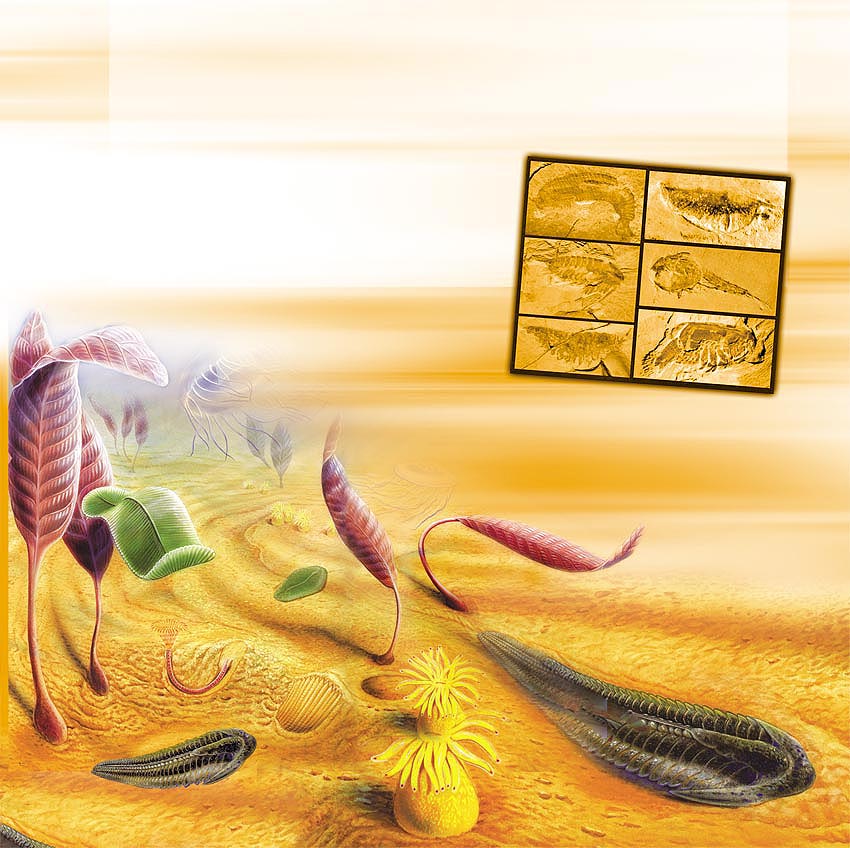Cambrian Fossils and The Creation of Species
The oldest of the Earth's strata in which the fossils of complex life forms appear were laid down in the Cambrian Period, estimated at between 543 and 490 million years ago. In strata older than the Cambrian, no fossils of living things are found, apart from single-celled organisms. In the Cambrian Period, however, a variety of distinctly different life forms suddenly appeared. More than 30 life forms, such as sea urchins, starfish, trilobites, snails and fish appeared in a single moment.
Furthermore, contrary to the assumptions of the theory of evolution, all of the life forms that appeared so suddenly possess highly complex physical structures, not simple "rudimentary" ones.
According to the erroneous theory of evolution, more sophisticated life forms must have evolved from other, more primitive ones. Yet there are no complex life forms at all prior to those of the Cambrian Period. These Cambrian life forms appeared all at once, with not a single earlier forerunner.
| Trilobite eye | |
 |
| A 380-Million-Year Old Trilobite Fossil |
| Trilobites are some of the most abundant life forms to have emerged in the Cambrian period. They lived in various parts of the world. One of the most astonishing characteristics of trilobites is their multi-lens eye, made up of numerous units, each unit being a separate lens. Each lens perceives a different image, and these are then combined as a whole "picture." Research has shown that there were more than 3,000 lenses in the trilobite eye, which meant the creature received more than 3000 images. This, in turn, clearly reveals how perfect were the eye and brain structure of this creature that lived nearly 530 million years ago. Such a flawless structure could not possibly have emerged by way of evolution. |
The British zoologist Richard Dawkins, the best-known living proponent of the theory of evolution, admits that:
It is as though they [Cambrian creatures] were just planted there, without any evolutionary history.11
This fact definitively invalidates the theory of evolution. Because in The Origin of Species, Darwin wrote:
If numerous species, belonging to the same genera or families, have really started into life all at once, the fact would be fatal to the theory of descent with slow modification through natural selection. 12
This lethal blow that Darwin so feared came from the Cambrian Period, at the very beginning of the fossil record.
New life forms also appeared suddenly and with complete, flawless structures in the ages after the Cambrian. Basic groups such as fish, amphibians, reptiles, birds and mammals each appeared on Earth in a single moment and in flawless forms. Not a single intermediate form of the kind hoped for by evolutionists exists among them.
 The Cambrian life forms unearthed in the Chengjang region of China display highly striking diversity and particularly intricate structures. These life forms have bodies made up of various sections, antennae with special functions, the ability to hunt and complex anatomical structures. The fact that such sophisticated creatures were alive roughly half a billion years ago entirely does away with the theory of species evolving from the simple to the more complex. |
This fact revealed by the fossil record proves that living things have not evolved from the simple to the more complex, neither functionally nor in terms of appearance, but were created by God. The evolutionist Mark Czarnecki admits as much:
A major problem in proving the theory has been the fossil record; the imprints of vanished species preserved in the Earth's geological formations. This record has never revealed traces of Darwin's hypothetical intermediate variants—instead species appear … abruptly, and this anomaly has fueled the creationist argument that each species was created by God.13


